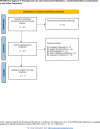Resting heart rate and incident atrial fibrillation: A stratified Mendelian randomization in the AFGen consortium
- PMID: 35594314
- PMCID: PMC9122202
- DOI: 10.1371/journal.pone.0268768
Resting heart rate and incident atrial fibrillation: A stratified Mendelian randomization in the AFGen consortium
Abstract
Background: Both elevated and low resting heart rates are associated with atrial fibrillation (AF), suggesting a U-shaped relationship. However, evidence for a U-shaped causal association between genetically-determined resting heart rate and incident AF is limited. We investigated potential directional changes of the causal association between genetically-determined resting heart rate and incident AF.
Method and results: Seven cohorts of the AFGen consortium contributed data to this meta-analysis. All participants were of European ancestry with known AF status, genotype information, and a heart rate measurement from a baseline electrocardiogram (ECG). Three strata of instrumental variable-free resting heart rate were used to assess possible non-linear associations between genetically-determined resting heart rate and the logarithm of the incident AF hazard rate: <65; 65-75; and >75 beats per minute (bpm). Mendelian randomization analyses using a weighted resting heart rate polygenic risk score were performed for each stratum. We studied 38,981 individuals (mean age 59±10 years, 54% women) with a mean resting heart rate of 67±11 bpm. During a mean follow-up of 13±5 years, 4,779 (12%) individuals developed AF. A U-shaped association between the resting heart rate and the incident AF-hazard ratio was observed. Genetically-determined resting heart rate was inversely associated with incident AF for instrumental variable-free resting heart rates below 65 bpm (hazard ratio for genetically-determined resting heart rate, 0.96; 95% confidence interval, 0.94-0.99; p = 0.01). Genetically-determined resting heart rate was not associated with incident AF in the other two strata.
Conclusions: For resting heart rates below 65 bpm, our results support an inverse causal association between genetically-determined resting heart rate and incident AF.
Conflict of interest statement
I have read the journal’s policy and the authors of this manuscript have the following competing interests: Dr. Lubitz receives sponsored research support from Bristol Myers Squibb / Pfizer, Bayer AG, Boehringer Ingelheim, Fitbit, and IBM, and has consulted for Bristol Myers Squibb / Pfizer, Bayer AG, and Blackstone Life Sciences. Dr. P.T. Ellinor is supported by a grant from Bayer AG to the Broad Institute focused on the genetics and therapeutics of cardiovascular disease, and consulted for Bayer AG, Novartis, MyoKardia, and Quest Diagnostics. This does not alter our adherence to PLOS ONE policies on sharing data and materials.
Figures



Similar articles
-
Genetic Obesity and the Risk of Atrial Fibrillation: Causal Estimates from Mendelian Randomization.Circulation. 2017 Feb 21;135(8):741-754. doi: 10.1161/CIRCULATIONAHA.116.024921. Epub 2016 Dec 14. Circulation. 2017. PMID: 27974350 Free PMC article.
-
Heart rate variability and atrial fibrillation in the general population: a longitudinal and Mendelian randomization study.Clin Res Cardiol. 2023 Jun;112(6):747-758. doi: 10.1007/s00392-022-02072-5. Epub 2022 Aug 13. Clin Res Cardiol. 2023. PMID: 35962833 Free PMC article.
-
Association between resting heart rate and incident diabetes risk: a Mendelian randomization study.Acta Diabetol. 2019 Sep;56(9):1037-1044. doi: 10.1007/s00592-019-01344-3. Epub 2019 Apr 15. Acta Diabetol. 2019. PMID: 30989380
-
How much should the resting heart rate be controlled in patients with atrial fibrillation and coronary heart disease?BMC Cardiovasc Disord. 2024 Nov 27;24(1):684. doi: 10.1186/s12872-024-04349-1. BMC Cardiovasc Disord. 2024. PMID: 39604833 Free PMC article. Clinical Trial.
-
Resting Heart Rate and the Risk of Atrial Fibrillation.Int Heart J. 2019 Jul 27;60(4):805-811. doi: 10.1536/ihj.18-470. Epub 2019 Jun 14. Int Heart J. 2019. PMID: 31204373 Review.
Cited by
-
Genetic insights into resting heart rate and its role in cardiovascular disease.Nat Commun. 2023 Aug 2;14(1):4646. doi: 10.1038/s41467-023-39521-2. Nat Commun. 2023. PMID: 37532724 Free PMC article.
-
Sex-specific and polygenic effects underlying resting heart rate and associated risk of cardiovascular disease.Eur J Prev Cardiol. 2024 Sep 20;31(13):1585-1594. doi: 10.1093/eurjpc/zwae092. Eur J Prev Cardiol. 2024. PMID: 38437179 Free PMC article.
-
Conventional and genetic associations between resting heart rate, cardiac morphology and function as assessed by magnetic resonance imaging: Insights from the UK biobank population study.Front Cardiovasc Med. 2023 Mar 17;10:1110231. doi: 10.3389/fcvm.2023.1110231. eCollection 2023. Front Cardiovasc Med. 2023. PMID: 37008308 Free PMC article.
-
Exploring the impact of electrocardiographic parameters on the risk of common arrhythmias: a two-sample Mendelian randomization study.J Thorac Dis. 2024 Jul 30;16(7):4553-4566. doi: 10.21037/jtd-24-814. Epub 2024 Jul 26. J Thorac Dis. 2024. PMID: 39144314 Free PMC article.
-
2023 ACC/AHA/ACCP/HRS Guideline for the Diagnosis and Management of Atrial Fibrillation: A Report of the American College of Cardiology/American Heart Association Joint Committee on Clinical Practice Guidelines.Circulation. 2024 Jan 2;149(1):e1-e156. doi: 10.1161/CIR.0000000000001193. Epub 2023 Nov 30. Circulation. 2024. PMID: 38033089 Free PMC article.
References
-
- Sharashova E, Wilsgaard T, Mathiesen EB, Lochen ML, Njolstad I, Brenn T. Resting heart rate predicts incident myocardial infarction, atrial fibrillation, ischaemic stroke and death in the general population: The tromso study. J Epidemiol Community Health. 2016;70(9):902–909. doi: 10.1136/jech-2015-206663 - DOI - PubMed
Publication types
MeSH terms
Grants and funding
- HHSN268201700001I/HL/NHLBI NIH HHS/United States
- HHSN268201700002I/HL/NHLBI NIH HHS/United States
- HHSN268201700003I/HL/NHLBI NIH HHS/United States
- HHSN268201700005I/HL/NHLBI NIH HHS/United States
- HHSN268201700004I/HL/NHLBI NIH HHS/United States
- R01 HL087641/HL/NHLBI NIH HHS/United States
- R01 HL059367/HL/NHLBI NIH HHS/United States
- R01 HL086694/HL/NHLBI NIH HHS/United States
- U01 HG004402/HG/NHGRI NIH HHS/United States
- K24 HL148521/HL/NHLBI NIH HHS/United States
- N01HC25195/HL/NHLBI NIH HHS/United States
- HHSN268201500001I/HL/NHLBI NIH HHS/United States
- 75N92019D00031/HL/NHLBI NIH HHS/United States
- R01 HL092577/HL/NHLBI NIH HHS/United States
- 75N92020D00001/HL/NHLBI NIH HHS/United States
- HHSN268201500003I/HL/NHLBI NIH HHS/United States
- N01HC95159/HL/NHLBI NIH HHS/United States
- N01HC95160/HL/NHLBI NIH HHS/United States
- N01HC95161/HL/NHLBI NIH HHS/United States
- N01HC95162/HL/NHLBI NIH HHS/United States
- N01HC95163/HL/NHLBI NIH HHS/United States
- N01HC95164/HL/NHLBI NIH HHS/United States
- N01HC95165/HL/NHLBI NIH HHS/United States
- N01HC95166/HL/NHLBI NIH HHS/United States
- N01HC95167/HL/NHLBI NIH HHS/United States
- N01HC95168/HL/NHLBI NIH HHS/United States
- N01HC95169/HL/NHLBI NIH HHS/United States
- 75N92020D00005/HL/NHLBI NIH HHS/United States
- 75N92020D00002/HL/NHLBI NIH HHS/United States
- 75N92020D00003/HL/NHLBI NIH HHS/United States
- 75N92020D00006/HL/NHLBI NIH HHS/United States
- 75N92020D00004/HL/NHLBI NIH HHS/United States
- 75N92020D00007/HL/NHLBI NIH HHS/United States
- N02 HL64278/HL/NHLBI NIH HHS/United States
- R01 HL128914/HL/NHLBI NIH HHS/United States
LinkOut - more resources
Full Text Sources
Medical

